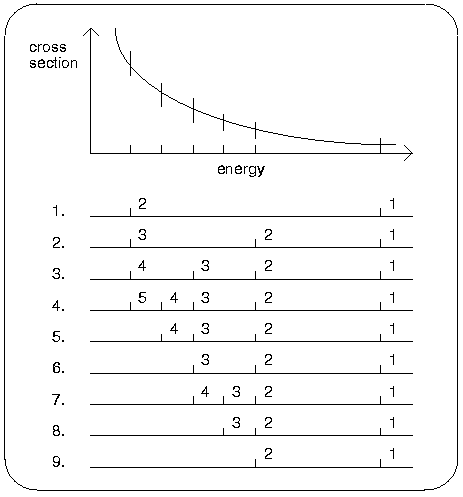The resonance range may consist entirely of resolved resonances, or there may be both resolved and unresolved ranges. We will discuss the unresolved part later. The resolved range usually starts at 1e-5 eV, or some other low energy (such as 1 eV) and extends until the resonance effects are small, or until a changeover to the unresolved representation occurs. The resonance parameters are given in File 2 with MT=151. For a more detailed description of the ENDF resonance formats, see our Introduction to the ENDF Formats. The cross sections in File 3 over the resolved range are usually zero, but in some cases, there may be small "background" cross sections that are to be added to the cross sections computed from the resonance parameters to correct for problems (such as the inadequacy of a single-level Breit-Wigner representation). ENDF provides discontinuities represented as double energy points at the ends of the resonance ranges. These regions of background cross section often confuse people who look at File 3 in ENDF evaluations and ask, "Why is the cross section zero? That can't be right!"
The ENDF format provides several options for representing resonance parameters. The most commonly used are
- Single-Level Breit-Wigner - simple and easy to use, but
not always as accurate as needed (can produce negative
cross sections),
- Multi-Level Breit-Wigner - gets rid of the negative cross
sections, but much more expensive to use. Can't represent
multichannel effects that are sometimes important.
- Reich-Moore - very faithful for all but the lightest nuclides. It is becoming the preferred representation for important materials.
RECONR reads in the resonance parameters, and it adds the resonance energies and the half-height energies to the list of nodes available from the linearization and unionization process. The resonance nodes are truncated to five significant digits. This makes it easier to find them on a PENDF listing, and it prevents them from being thinned away in BROADR. This choice of starting nodes for the resonance reconstruction process assures that no important structures will be missed. The code then works through each panel defined by these nodes, compares the cross section computed at the midpoint with a linearly interpolated value, and decides whether to add the new midpoint to the grid. This process of halving and checking continues until convergence is achieved over the entire energy range using a special inverted-stack logic that is also used elsewhere in NJOY. The following figure shows the points in the stack at several different stages of the linearization of an energy panel.

Once the resonance energy grid and the resonance cross sections have been determined, RECONR merges them with the linearized and unionized ENDF cross sections, and write the results on an output file in PENDF format.